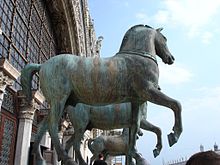San Marco horses

The horses of San Marco (also: Quadriga marciana , Quadriga of St. Mark's Basilica and other names) are a group of four life-size gilded bronze sculptures , the modern copies of which adorn the loggia at the west portal of St. Mark's Basilica in Venice . The original sculptures, which are exhibited today in the museum of the cathedral, are parts of the only other free plastic quadriga that have survived from the ancient times .
description
The statues are each 1.60 meters tall and weigh 875 kilograms. They are mainly made of gold-plated copper. Each horse statue consists of two parts. The seam line is on the neck and is covered by a decorative ribbon.
history
The origin and exact age of the horse statues from San Marco are still disputed today. It is most likely to have originated in the 2nd or 3rd century AD. According to hypotheses, the four-in-hand car adorned a triumphal arch or the mausoleum of Emperor Hadrian as part of a quadriga in Rome and later made it to Constantinople. The horses were brought to Venice by the Crusaders in 1204 after the sack of Constantinople - where they were presumably placed in the hippodrome - but were not included in the artistic facade design of the Basilica San Marco until around the middle of the 13th century.
The legend has long circulated about the origin and importance of horses that Emperor Friedrich I had Venice besieged in a conflict with the Pope and swore that he would not abandon his plan until he had converted St. Mark's Basilica into a horse stable . After the siege had failed, either himself or the victorious Venetians placed the horses on the church in order to at least symbolically fulfill his oath.
After Napoleon had eliminated the Republic of Venice , in 1798 he had its landmarks, the Lion of St. Mark and the four golden horses to crown the Arc de Triomphe du Carrousel, brought to Paris. As a result of the Congress of Vienna , France had to return the looted horses in 1815. The Arc de Triomphe du Carrousel has since carried copies of François Joseph Bosio's horses .
During the First World War , the horses, like other art treasures in Northern Italy, were brought to safety by the Allies in Rome and temporarily stored in the Castel Sant'Angelo. The bronze sculptures stood on the loggia at the west portal until 1977. After restoration, they were replaced by copies and the originals have since been exhibited in the Museum of San Marco.
literature
- Michael Jacoff: The Horses of San Marco and the Quadriga of the Lord. Princeton University Press, Princeton NJ 1993, ISBN 0-691-03270-X .
- The horses of San Marco. Catalog for the exhibition in the Martin-Gropius-Bau Berlin March 8 to April 25, 1982. Frölich and Kaufmann, Berlin 1982, ISBN 3-88725-006-0 .
- Stefan Schweizer: Rosse von San Marco / Quadriga. In: The New Pauly (DNP). Volume 15/2, Metzler, Stuttgart 2002, ISBN 3-476-01488-6 , Sp. 988-991.
Web links
Individual evidence
- ↑ Meraviglie di Venezia. Retrieved February 8, 2020 .
- ↑ Bodo Schwalm: With eyes and senses: Selected and worth seeing for "advanced travelers" . Books on Demand, 2015, ISBN 978-3-7386-6929-9 ( google.de [accessed February 10, 2020]).
- ↑ St. Mark's Basilica. Retrieved February 10, 2020 .
- ^ Marilyn Perry: Saint Mark's Trophies. Legend, Superstition, and Archeology in Renaissance Venice. In: Journal of the Warburg and Courtauld Institutes. 40, 1977, pp. 28-34, doi : 10.2307 / 750990 .
- ^ Walter Frodl : Idea and Realization: The Becoming of the State Preservation of Monuments in Austria . Böhlau, Vienna 1988, ISBN 3205051548 , p. 29.

